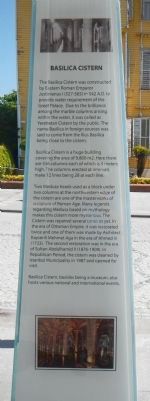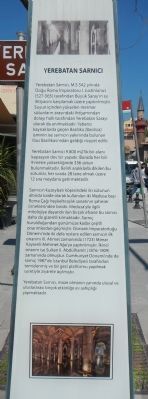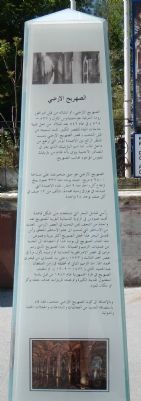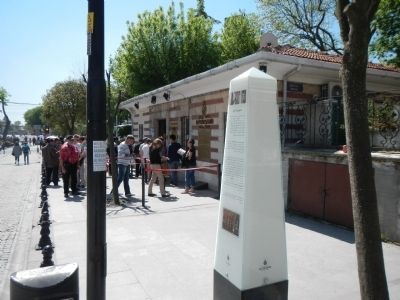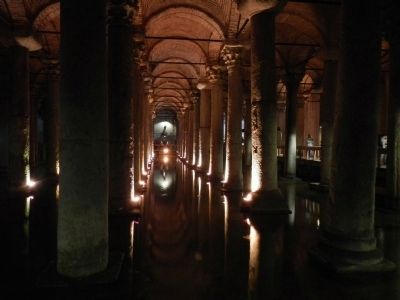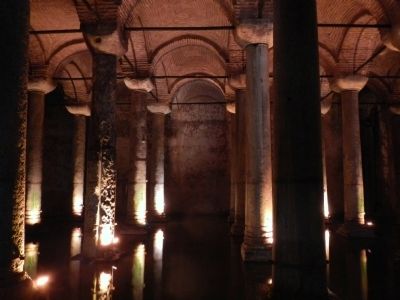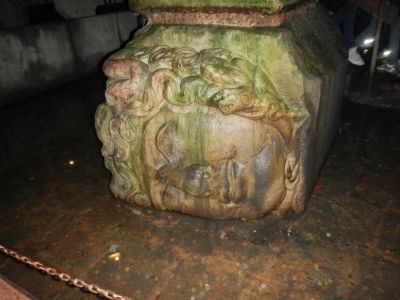Alemdar in İstanbul in Fatih, Turkey — West Asia or Southeast Europe
Basilica Cistern
Yerbatan Sarnıcı
The Basilica Cistern was constructed by Eastern Roman Emperor I. Justinianus (527-565) in 542 A.D. to provide water requirement of the Great Palace. Due to the brilliance among the marble columns arising within the water, it was called as Yerebatan Cistern by the public. The name Basilica in foreign sources was said to come from the Ilius Basilica being close to the cistern.
Basilica Cistern is a huge building covering the area of 9.800 m2. Here there are 336 columns each of which is 9 meters high. The columns erected at intervals make 12 lines being 28 at each line.
Two Medusa heads used as a block under two columns at the northwestern edge of the cistern are one of the masterworks of sculpture of Roman Age. Many legends regarding Medusa based on mythology makes this cistern more mysterious. The Cistern was repaired several times as yet. In the era of Ottoman Empire, it was restorated (sic) twice and one of them was made by Architect Kayserill Mehmet Aga in the era of Ahmed III (1723). The second restoration was in the era of Sultan Abduihamid II (1876-1909). In Republican Period, the cistern was cleaned by Istanbul Municipality in 1987 and opened for visit.
Basilica Cistern, besides being a museum, also hosts various national and international events.
Turkish:
Yerebatan Sarnıcı, M.S 542 yılında Doğu Roma İmparatoru l. Justinianus (527-565) tarafından Büyük Saray'in su ihtiyacını karşılamak üzere yaptırılmıştır. Suyun içinden yükselen mermer sütunların arasındaki dolayı halk tarafından Yerebatan Sarayı olarak da anılmaktadır. Yabancı kaynaklarda geçen Basilika (Basilica) isminin ise sarnıcın yakınında bulunan Ilius Basilikası'ndan geldiği rivayet edilir.
Yerebatan Sarnıcı 9.800 m2'lik bir alanı kapsayan dev bir yapıdır. Burada her biri 9 metre yüksekliğinde 336 sütun bulunmaktadır. Belirli aralıklarla dikilen bu sütunlar, her sırada 28 tane olmak üzere 12 sıra meydana getirmektedir.
Sarnıcın kuzeybatı köşesindeki iki sütunun altında kaide olarak kullanılan iki Medusa başı Roma Çağı heykeltıraşlık sanatının şaheser örneklerinden biridir. Medusa'yla ilgili mitolojiye dayandırılan birçok efsane bu sarnıcı daha d onarımlardan geçmiştir. Osmanlı İmparatorluğu Dönemi'nde iki defa restore edilen sarnıcın ilk onarımı III. Ahmet zamanında (1723) Mimar Kayserili Mehmet Ağa'ya yaptırılmıştır. İkinci onarım ise Sultan ll. Abdülhamit (1876-1909) zamanında olmuştur. Cumhuriyet Dönemi'nde de sarnıç 1987'de İstanbul Belediyesi tarafından temizlenmiş ve bir gezi platformu yapılmak suretiyle ziyarete açılmıştır.
Yerebatan Sarnıcı, müze olmanın yanında ulusal ve uluslararası birçok etkinliğe ev sahipliği yapmaktadır.
Arabic: To read the Arabic text, click on the Arabic image to enlarge it.
Erected by Istanbul Büyükşehir Belediyesi (Istanbul Metropolitan Municipality).
Topics. This historical marker is listed in this topic list: Charity & Public Work. A significant historical year for this entry is 1987.
Location. 41° 0.507′ N, 28° 58.675′ E. Marker is in İstanbul, in Fatih. It is in Alemdar. Marker is on Yerebatan Caddesi close to Alaemdar Caddesi, on the right when traveling south. Touch for map. Marker is at or near this postal address: Yerebatan Cd 13, İstanbul 34110, Turkey. Touch for directions.
Other nearby markers. At least 8 other markers are within walking distance of this marker. A different marker also named The Basilica Cistern (here, next to this marker); Million (within shouting distance of this marker); The Milion Stone (within shouting distance of this marker); Hagia Sophia (about 120 meters away, measured in a direct line); The Türbe (Tomb) of Sultan Selim II (about 150 meters away); Firuz Aga Mosque (about 150 meters away); The Remnants of the Theodosian Hagia Sophia (5th Century) (about 150 meters away); Mausoleum of Sultan Ahmed I (about 150 meters away). Touch for a list and map of all markers in İstanbul.
Also see . . . Basilica Cistern - Wikipeida. The Basilica Cistern (Turkish: Yerebatan Sarayı – "Sunken Palace", or Yerebatan Sarnıcı – "Sunken Cistern"), is the largest of several hundred ancient cisterns that lie beneath the city of Istanbul (that is formerly Constantinople), Turkey. The cistern, located 500 feet (150 m) southwest of the Hagia Sophia on the historical peninsula of Sarayburnu, was built in the 6th century during the reign of Byzantine Emperor Justinian I. (Submitted on June 26, 2015, by Barry Swackhamer of Brentwood, California.)
Credits. This page was last revised on February 13, 2023. It was originally submitted on June 26, 2015, by Barry Swackhamer of Brentwood, California. This page has been viewed 500 times since then and 19 times this year. Photos: 1, 2, 3, 4, 5, 6, 7. submitted on June 26, 2015, by Barry Swackhamer of Brentwood, California. • Andrew Ruppenstein was the editor who published this page.
